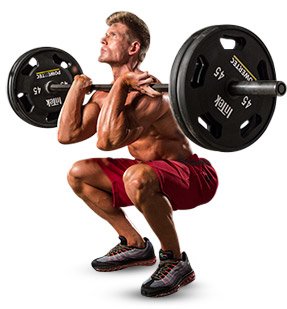As nice as it would be to have unlimited training time, it's simply not in the cards for most people. The gym is great, but a little thing called life often throws a wrench in your best-laid plans. Realistically, even the most dedicated people can only attend the gym 3-5 days per week for an hour per day, and that's with a little luck.
The good news is that one hour per session is plenty of time, if you use your time wisely! You just have to be smart with your exercise selection and workout program. Enter "power pairings," which are specific superset-style exercise pairs I created to help you get the most out of your precious training time.
As with any superset, you perform power pairings without resting between the paired exercises. Take a bench press and chin-up pair, for example. You perform one set of bench press followed immediately by a set of chin-ups. You won't rest until after you complete both exercises.
Pairing Power

Power pairings can be useful within full-body routines or body-part splits, but for this article I'll explain how to use them in full-body routines. Full-body workouts are my go-to method when life gets hectic. In a full-body routine, you'd use a power pairing after your primary lift. This allows you to give your first lift maximum attention and strength.
Start your workout with a big-bang strength movement and devote your full energy and attention to it. When you finish your main lift, implement a power pairing as your finisher. Power pairings use one piece of equipment and require little to no setup, which makes them easy to use even in crowded gyms.
Here are four power pairings that you can add to your own training program to cut down on your overall workout time and still get a great training effect!
1
Ring Dip And Chin-Up/Hip Thrust Combo
Pair ring dips with a chin-up/hip thrust combination exercise I created to blast the back, glutes, and hamstrings simultaneously. Rather than confusing you by trying to explain the exercise, here's a video of what it looks like in action:
From a strength and muscle-building standpoint, this pairing works well because the exercises focus on different body parts, so they won't negatively impact each other or impair your strength. From a logistical standpoint, it's a great pair because the ring height is the same for each exercise, which means no necessary adjustments between sets.
To up the ante, try the pairing in a countdown format, as demonstrated in the video. Rather than doing straight sets of each exercise, start by doing decreasing sets of 10, 8, 6, 4, and 2 reps of each exercise with little to no rest between sets. Be warned: This is not for the faint of heart.
Use it: This pair works as a brutal finisher to cap off a great heavy, knee-dominant exercise like the front squat, back squat, split squat, or lunge.
2
"Bottoms Up" Front Squats And Inverted Rows
Instead of starting in the standing position, "bottoms up" squats call for you to start at the bottom of the rep and lift from the squat rack's safety pins. Pause after each rep! This is a great front squat variation to hammer your quads and core, and help you build strength out of the hole.
After you finish the front squats, leave the bar on the pins and use it to perform a set of inverted rows. The bar will be at a perfect height to allow for full range of motion with no adjustments. It works great from a logistical standpoint.
In the video below, I use chains on the front squats, which is great if you have chains at your disposal, but they're not essential.
Use it: This pairing is an ideal finisher after a heavy bench press or overhead press variation.
3
Rack RDL And Split-Stance Row Combo
I recommend doing RDLs and barbell rows from the safety pins of a squat rack. Reset after each rep to take stress off your lower back and encourage proper form. I also recommend doing barbell rows with a split stance to take stress off the lower back, because the split stance helps prevent against lower-back rounding.
Fortunately, the proper pin height is the same for each exercise, so it works well as a pairing. You'll almost undoubtedly be able to use more weight on RDLs than barbell rows, so you'll need to change the weight, which is a breeze because the bar is raised off the floor. This video below shows how the pair looks in action. I use an oversized trap bar, which is great if you have one, but you can just as easily use a standard barbell.
If you use a barbell, here is how the rows look.
Use it: This pair goes well after a heavy pressing day.
4
Overhead Press And Front Squats
Pairing overhead presses with front squats works well because you don't need to waste time adjusting the bar in the rack. It's set to the same height for each exercise, making this a killer combo.
I recommend doing the overhead press before the front squats, because after much experimentation, I found that the overhead press doesn't negatively impact the subsequent front squats. Alternatively, if you do the front squats first, the overhead press suffers.
It's also important to note that most people will be much stronger on front squats than overhead press. This gives you two options: add weight for each set of front squats, or simply do more reps. I usually choose the latter and do twice as many front squats as overhead presses, as I do in this video.
Use it: This pairing works perfectly as a finisher after doing a heavy chin-up or row variation. It's also ideal as a standalone workout when you're really pinched for time and still want to get a good training effect.
Putting It All Together
Here's an example of how to utilize these power pairings within a full-body workout program to keep your workouts brief but effective. Shoot to train 2-4 days per week and rotate the workouts as necessary.
Workout 1:
A1. Front Squats: 5 sets of 6 reps
B1. Ring Dips: 5 sets of 10, 8, 6, 4, and 2 reps
B2. Chin-Up/Hip Thrust Combo: 5 sets of 10, 8, 6, 4, and 2 reps
Workout 2:
A1. Incline Bench Press: 5 sets of 6 reps
B1. "Bottoms Up" Front Squats: 4 sets of 10 reps
B2. Inverted Rows: 4 sets of 10 reps
Workout 3:
A1. Dumbbell Bench Press: 5 sets of 8 reps
B1. Rack RDL: 4 sets of 8 reps
B2. Split-Stance Rack Row: 4 sets of 8 reps
Workout 4:
A1. Chin-ups: 5 sets of 6 reps
B1. Overhead Press: 4 sets of 6 reps
B2. Front Squats: 4 sets of 12 reps
